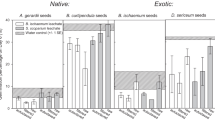Abstract
Black alder trees were interplanted with black walnut on a 2.4 × 3.7-m spacing at four locations in Illinois and Missouri. In every plantation, the alders suddenly declined and died after 8–13 years. Alternative causes for the mortality were investigated–competition from walnut, adverse soil properties, frost, insects, disease, unsuitable seed source, and allelopathy—but only allelopathy could be substantiated. The decline in alder survival and diameter growth was strongly related to walnut above-ground dry biomass and walnut crown competition factor. We propose that the black walnut allelopathy most likely results from a combination of (1) sufficient walnut biomass to contribute substantial amounts of juglone to the environment, and (2) wet soil that greatly restricts aerobic metabolism by soil microorganisms, allowing juglone to build up to toxic levels.
Similar content being viewed by others
References
Alexander, M. 1977. Introduction to Soil Microbiology, 2nd ed. John Wiley & Sons, New York, 467 pp.
Anonymous. Ca. 1981. Trees for reclamation—European black alder (Alnus glutinosa). USDA For. Serv., Northeast. For. Exp. Stn. and Northeast. Area State and Private Forestry, Broomall, Pennsylvania, 2 pp.
Boyette, W.G., andBrenneman, D. L. 1978. Apparent winter damage to European black alder in North Carolina.N.C. For. Serv. For. Note No. 33, 5 pp.
Davis, E.F. 1928. The toxic principle ofJuglans nigra as identified with synthetic juglone and its toxic effects on tomato and alfalfa plants.Am. J. Bot. 15:620.
Dawson, J.O. andSeymour, P.E. 1983. Effects of juglone concentration on growthin vitro ofFrankia ArI3 andRhizobium japonicum strain 71.J. Chem. Ecol. 9:1175–1183.
Fehrenbacher, J.B., Walker, G.O., andWascher, H.L. 1967. Soils of Illinois. Univ. of IL Coll. Agric., Agric. Exp. Stn., and USDA Soil Conservation Serv., Urbana, Illinois, 47 pp.
Fisher, R.F. 1977. Juglone inhibits red pine growth under certain moisture regimes.Agron. Abstr. 1977:180–181.
Fishes, R.F. 1978. Juglone inhibits pine growth under certain moisture regimes.J. Soil Sci. Soc. Am. 42:801–803.
Fisher, R.F. 1979. Allelopathy, pp. 313–330,in Plant Disease: An Advanced Treatise, Vol. IV. Academic Press, New York.
Funk, D.T. 1979.Alnus glutinosa trials in Ohio strip mines: Sixteen-year results, pp. 28–32,in Proc. First North Central Tree Improv. Conf., Madison, Wisconsin.
Funk, D.T. 1983.Alnus glutinosa. European alder,in Silvics of Forest Trees of the United States, revised edition. In press.
Funk, D.T., Schlesinger, R.C., andPonder, F., Jr. 1979. Autumn olive as a nurse plant for black walnut.Bot. Gaz. 140(Suppl.):5110–5114.
Goncalves, P.Des., andKellison, R.C. 1980. North Carolina State Univ., School of Forest Resources Tech. Rep. No. 62, 31 pp.
Jensen, T.E., andWelbourne, 1962. The cytological effect of growth inhibitors on excised roots ofVicia faba andPisum sativum.Proc. S.D. Acad. Sci. 41:131–136.
Koeppe, D.D. 1972. Some reactions of isolated corn mitochondria influenced by juglone.Physiol. Plant. 27:89–94.
Krajicek, J.E., Brinkman, K.A., andGingrich, S.F. 1961. Crown competition—a measure of density.For. Sci. 7:35–42.
Larson, M.M., andSchwarz, E.L. 1980. Allelopathic inhibition of black locust, red clover, and black alder by six common herbaceous species.For. Sci. 25:511–520.
Lee, K.C., andCampbell, R.W. 1969. Nature and occurrence of juglone inJugions nigra L.Hortscience 4:297–298.
Losche, C.K., Clark, W.M., Voss, E.L., andAshley, B.S. 1980. Guide to the selection of soil suitable for growing black walnut in Illinois. Revision of 1972 Special Publication, Northeastern Area, State and Private Forestry, Upper Darby, Pennsylvania, 45 pp.
MacDaniels, L.H., andPinnow, D.L. 1976. Walnut toxicity, an unsolved problem.North. Nut Grow. Assoc. Annu. Rep. 67:114–121.
McVean, D.N. 1953. Biological flora of the British Isles:Alnus glutinosa (L.) Gaertn. J. Ecol. 41:447–466.
Munch, E. 1936. Das Erlensterben.Forstwiss. Centralbl. 58:173–194.
Oak, S.W., andDorset, R.D. 1983.Phomopsis canker of European black alder found in Kentucky seed production areas.Plant Dis. 67:691–693.
Plass, W.T. 1977. Growth and survival of hardwood and pine interplanted with European alder. USDA For. Serv. Res. Pap. NE-376, 10 pp.
Rietveld, W.J. 1982. The significance of allelopathy in black walnut cultural systems.North. Nut Grow. Assoc. Annu. Rep. 72:117–134.
Schlesinger, R.C. andWilliams, R.D. 1984. Nurse crops improve black walnut growth.For. Sci. Submitted.
Schrivner, C.L.,Baker, J.C., andMiller, B.J. 1966. Soils of Missouri, a guide to their identification and interpretation. Univ. of Mo. Exten. Div., 48 pp.
Smith, D.M. 1962. The Practice of Silviculture. John Wiley & Sons, New York, 578 pp.
Yen, C.P.,Pham, C.H.,Cox, G.S., andGarrett, H.E. 1978. Soil depth and root development patterns of Missouri black walnut and certain Taiwan hardwoods, pp. 36–42,in Proc. of Symp. of Root Form of Planted Trees, Victoria, B.C., Canada, May 16–19, 1978.
Author information
Authors and Affiliations
Rights and permissions
About this article
Cite this article
Rietveld, W.J., Schlesinger, R.C. & Kessler, K.J. Allelopathic effects of black walnut on european black alder coplanted as a nurse species. J Chem Ecol 9, 1119–1133 (1983). https://doi.org/10.1007/BF00982216
Received:
Revised:
Issue Date:
DOI: https://doi.org/10.1007/BF00982216




